Warbirds Check Out Vol 6
Warbirds Check Out Vol 6
Warbirds Check Out Vol 6
Warbirds Check Out Vol 3
Warbirds Over Kalamazoo
Blue Angels & Thunderbirds
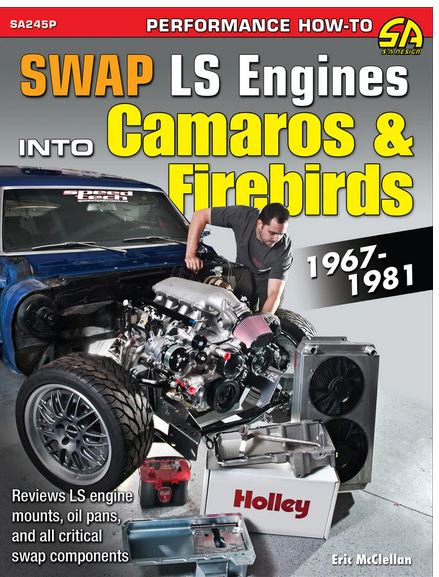
The 1967-1981 Camaros and Firebirds are enduring classics that include the Z28, Firebird Formula 400, and the Smokey and the Bandit edition Trans Ams. But many owners want their rides to have the latest and greatest in GM engine technology and performance, and that’s the LS engine. These F-Body cars readily accept these compact, lightweight modern V-8 engines. The LS engines produce more horsepower per cubic inch than almost all other pushrod V-8 engines, so the combination of the LS engine and a Camaro or Firebird make for an extraordinary performance car. And that’s precisely why these engine swaps have become so popular.
To perform a professional caliber LS engine swap into a Camaro or Firebird, you need proper planning, the right combination of parts, and information to complete the project. Swap LS Engines into Camaros & Firebirds: 1967-1981 provides excellent instruction and guidance for selecting the best engine for a budget, choosing the adapter plates and engine mounts, dropping the engine into the car, selecting the ideal transmission and drivelines, and completing all facets of the swap. You need to ensure that all the other components on the car are compatible with the engine, so author McClellan instructs readers how to integrate the electronic engine control system on the early F-Body cars as well as select and install exhaust, intake, fuel pumps, and upgrade cooling system for the high-performance LS.
While the swapping process is covered in detail, the author also provides a helpful Gen III and Gen IV LS engine guide, so the reader finds the best performing and reliable engine suited for a particular car and application, such as Pro Touring, drag racing, and high-performance street. In addition, the author explains how to shop for and buy a used LS engine from a salvage yard, so you get a good engine with all required accessories. When you are ready to swap a stock powerplant engine for a GM LS, you are going to need this book.
The photos in this edition are back & white.
The International Rescue Thunderbirds is an inventive, informative and entertaining guide to the world’s foremost rescue organization. Featuring cutaway drawings, detailed diagrams, color illustrations and photographs, the book provides the ultimate visual insight into the secrets of the fabulous International Rescue team. Presented as if it were to be used by International Rescue field agents, the International Rescue Thunderbirds includes an introduction by Jeff Tracy and operational procedures for agents’ missions.

The continuation of World War II’s most intriguing new aviation series.
In Hidden Warbirds II, the engaging follow-up to the critically acclaimed Hidden Warbirds, aviation historian Nicholas A. Veronico further explores the romantic era of World War II warbirds and the stories of some of its most famous wrecks and recoveries. The long-lost aircraft featured in this much-anticipated sequel include a Hawker Tempest being restored in Texas; the sole surviving Brewster F3A Corsair, rescued from a swamp; and a Junkers 88 recovered from the icy waters of Norway. Throughout the book, Veronico provides a history of each aircraft, as well as the unique story behind each discovery and recovery, all accompanied by incredible documentary photographs. With over 150 of these photographs, depicting more than 20 warbird stories spanning the world, Hidden Warbirds II triumphantly continues a nonfiction series that renowned military author Alan Griffith calls “a fascinating joy to read.”

Aviation historian Nicholas A. Veronico has been investigating and writing about aircraft wrecks for many years. His website, wreckchasing.com, is the go-to source for enthusiasts who want to know more about how to locate vintage airplane wrecks and then tell their stories. In this engaging new book, Veronico explores the romantic era of World War II Warbirds and the stories of some of its most famous wrecks, including the “Swamp Ghost” (a B-17E which crashed in New Guinea in the early days of World War II and which was only recently recovered), and “Glacier Girl” (a P-38, part of “The Lost Squadron,” which crashed in a large ice sheet in Greenland in 1942). Throughout, Veronico provides a history of the aircraft, as well as the unique story behind each discovery and recovery with ample illustrations. Hidden Warbirds is aviation history at its best.
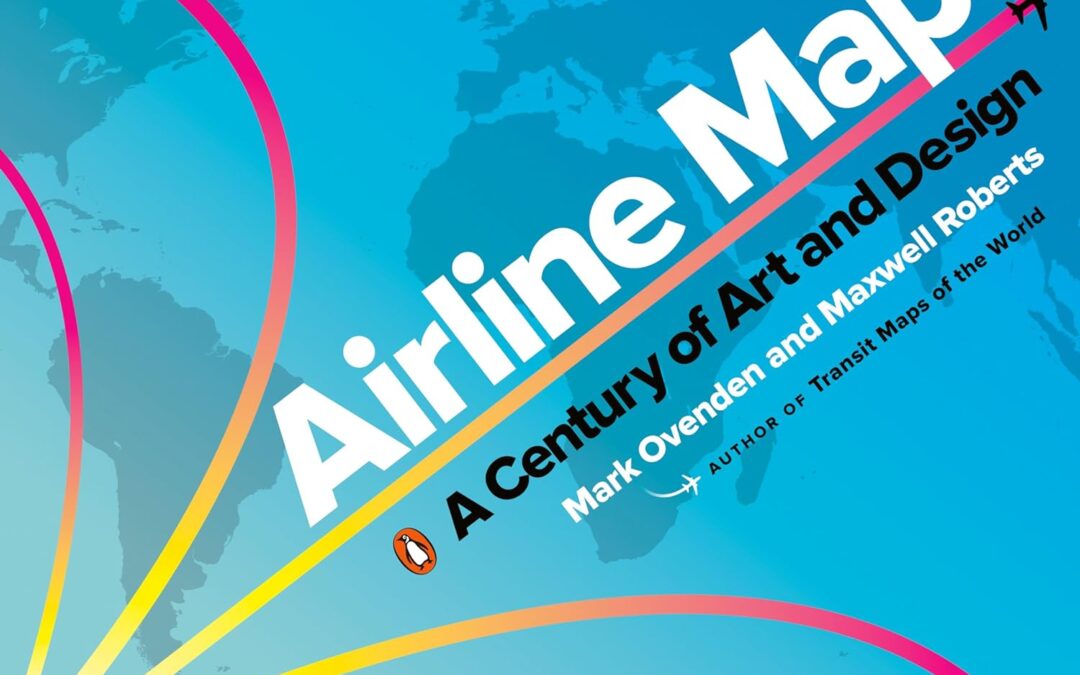
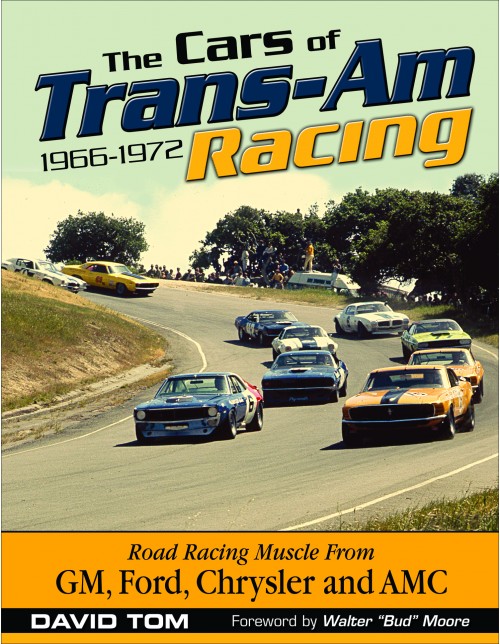
The legendary history of the pony car wars comes to life in this softcover edition of The Cars of Trans-Am Racing.
The SCCA Trans-Am Racing Series launched in 1966 and was designed to showcase a new class of sporty domestic cars racing on road courses. Each major automotive manufacturer participated heavily in the Trans-Am Series, and in a few short years, it became the ultimate American automobile showdown. When the modified muscle cars of the series were seen performing well on the country’s finest tracks, fans wanted a model of their own in the driveway. These “pony cars” boasted a new look and style not seen before, and their all-around performance eclipsed anything accomplished by production-based American GT cars up to that point.
This softcover edition of The Cars of Trans-Am Racing is unique in that it focuses on the cars used in this legendary series. These vintage Mustangs, Camaros, Challengers, Barracudas, Firebirds, Cougars, and Javelins all are extremely popular with collectors and enthusiasts today. Seeing them in their full-competition versions when they were new will bring back many fond memories for those who were fans of this series. In addition, enthusiasts who enjoy these cars today look to the Trans-Am Series cars for styling inspiration and performance hints as part of the growing Pro Touring trend.
Many of these historic cars have been restored to race-ready condition. Additional insight and interviews from the original builders and the teams that maintained the cars provide an insider’s viewpoint never before seen in print
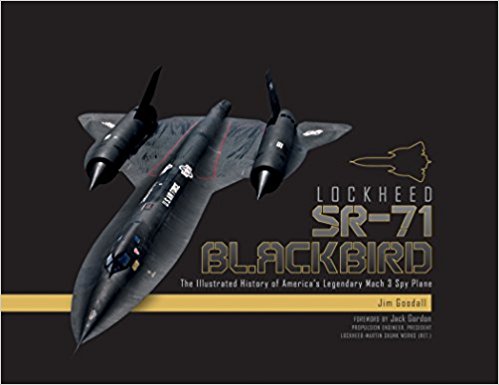
The legendary SR-71 Blackbird spy plane was, and still is, the world’s only operational Mach 3 aircraft, and was designed, built, and tested by Lockheed’s famed “Skunk Works.” This new book covers all fifty Blackbirds built, from the first flight in 1962, to the last in 1999. As a replacement for the venerable U-2 spyplane, Lockheed went from contract signing to first flight in only thirty-two months starting in April 1958―from the beginning of design studies to the signing of a contract from the CIA to build the initial batch of A-12s in February 1960, to first flight in 1962. From the A-1 design through the completion of the very first Radar Cross Section models of the A-12, to the testing of every major system and subsystem, this book describes and illustrates the SR-71 as never before, using images from a variety of sources, as well as the author’s own superb, new photography.

“Petty signs with Ford!” Those four words tore through the racing world like a hot knife through butter while loyalists threw their hands up in disbelief. King Richard’s defection was in part because Plymouth hadn’t built a Dodge Daytona counterpart for the NASCAR circuit, in addition to the fact that Petty Enterprises wanted to be the sole racing parts distributor for Plymouth at the time. Plymouth weathered the backlash publically while privately scurrying to create a car to lure Richard back to Plymouth. That car? The 1970 Plymouth Superbird.
Production models languished on salesroom floors due in part to NASCAR having increased the homologation requirement from 500 units to 2,000. These cars were highly specialized, seen as being in excess in proportion to the hottest street cars of the period. Fast-forward to today, Superbirds are highly collectible and are the star attractions at car shows and auctions, pulling top dollar and generating real excitement. What a difference a few decades makes!
Each volume in the In Detail Series provides an introduction and historical overview, an explanation of the design and concepts involved in creating the car, a look at marketing and promotion, an in-depth study of all hardware and available options, and an examination of where the car is on the market today. Also included are paint and option codes, VIN and build tag decoders, as well as production numbers.

After the extremely successful debut of the first-generation Firebirds and Camaros, General Motors had a tall task ahead. It had to create an equally popular yet radically different version of the groundbreaking pony car it was replacing. Enthusiasts picked up on the “radically different” part as soon as they saw these cars. Over time, we have come to appreciate how successful these second-generation cars were. They include the early models that had an emphasis on performance along with the continued development of the Trans Am, the 455 Super Duty cars of 1973 and 1974, and the lightning-in-a-bottle popularity of the Smokey and the Bandit editions. During their production run, these Firebirds and Trans Ams were truly the only real performance cars out of Detroit, and for many of the model years, they eclipsed even the mighty Corvette.
In The Definitive Firebird & Trans Am Guide 1970-1/2-1981, Pontiac expert and historian Rocky Rotella examines each production year of the second generation of Firebirds. Production figures, option codes, running changes, model-year changes and variances, rarity, collectability, interviews with engineers, and more are thoroughly covered. This is sure to become the ultimate second-generation Firebird reference book. Complementing the detail and year-by-year analysis is a combination of archival photography from the development of these cars as well as beautiful color photos of original and restored examples today.
This book tells the entire story of these immensely popular cars, whether you are into the second generation of F-Body regular models, Formula 400 performance models, the Super Duty Trans Ams, or the cars of Smokey and the Bandit fame. It is an excellent addition to any pony car, muscle car, or any enthusiast’s library.

Donald Campbell was the only son of the legendary Sir Malcolm Campbell, famous in the inter-war years as the ultimate record breaker with nine land- and four water-speed records. This richly illustrated book provides a unique insight into the life of a brave and intense man obsessed with doing better than his father and flying the flag for Britain. With new and rare material, it reveals the record attempts made with the Bluebirds, played out against the barren backdrop of Lake Eyre in Australia and the verdant hills surrounding Coniston Water in the English Lake District.
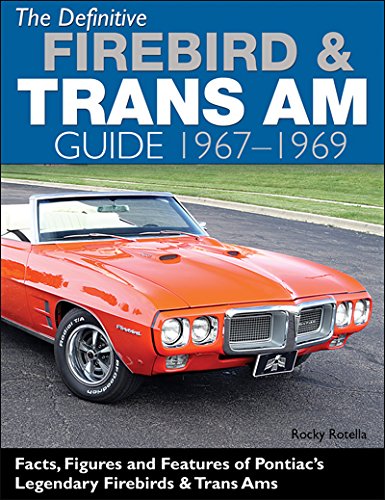
Facts, figures and features of Pontiac’s legendary Firebirds and Trans Ams
In the mid-1960s, Ford Motor Company took the automotive world by storm with the release of its new “pony car,” the Ford Mustang. It was the right car for the right time, and it caught General Motors by surprise. One year later, after seeing the Mustang’s enormous sales success, General Motors announced the development of its own pony-car platform, code-named “Panther,” to compete with the tremendously popular Mustang. And what a competition it became. Chevrolet Camaros and Pontiac Firebirds hit the market as 1967 models, and the world clamored for more of these new Mustang killers. These F-Body cars became some of the most popular enthusiast cars of all time.
In The Definitive Firebird & Trans Am Guide 1967-1969, Pontiac expert and historian Rocky Rotella examines each production year of the first generation of Firebirds. Production figures, option codes, running changes, model year changes and variances, rarity, collectability, interviews with engineers, and more are thoroughly covered in what is sure to become the ultimate Firebird reference book. Complementing the detail and year-by-year analysis is a combination of archival photography from the launch of these cars and beautiful color photos of original and restored examples.
Whether you are into the first generation of F-Body convertibles, Formula 400 performance models, the special overhead cam Sprint 6s, or even the first Trans Ams of 1969, this book tells the entire story of these immensely popular cars. It is an excellent addition to any pony car, muscle car, or any enthusiast’s library.
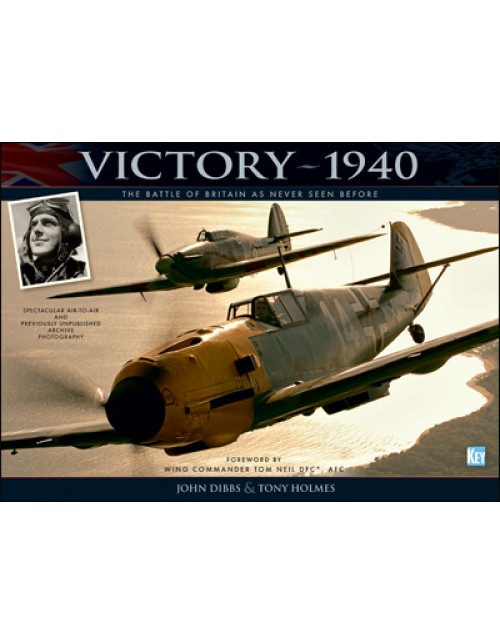
Scramble! Scramble! Seventy-five years ago the skies over Britain were full of dogfighting aircraft as young pilots of the RAF fought to repel the might of the German war machine. Described by Prime Minister Winston Churchill as ‘Their Finest Hour.’ The Battle of Britain is a defining moment in recent history and remains an inspiration to us all.
Victory 1940 presents a pictorial chronology of the legendary fight, when the might of the Luftwaffe was defeated for the first time by Churchill’s ‘Few.’
The history of the battle as been recounted many times, but this book offers a new and exclusive approach, through razor-sharp contemporary imagery of restored Battle of Britain warbirds combined with extensive archive material previously unpublished.
The graphic illustrations of Victory 1940 are supported by a riveting account of the greatest air battle of all time, as seen through the eyes of the combatants from both sides. We witness their triumph and tragedies as they battle for a cause and survival itself.
Victory 1940 draws upon John Dibbs’ amazing warbird photograpy, and his Battle of Britain restored image archive, which provide fresh insights into the events of 1940 and enhance the compelling text.
In his exclusive foreword to Victory 1940, Battle of Britain Hurricane ace Tom Neil calls for ‘the need to implant in the minds of the young, the gallantry and sacrifices of those who fought in the Battle of Britain,’ and that for this reason the book should be ‘read and enjoyed.’
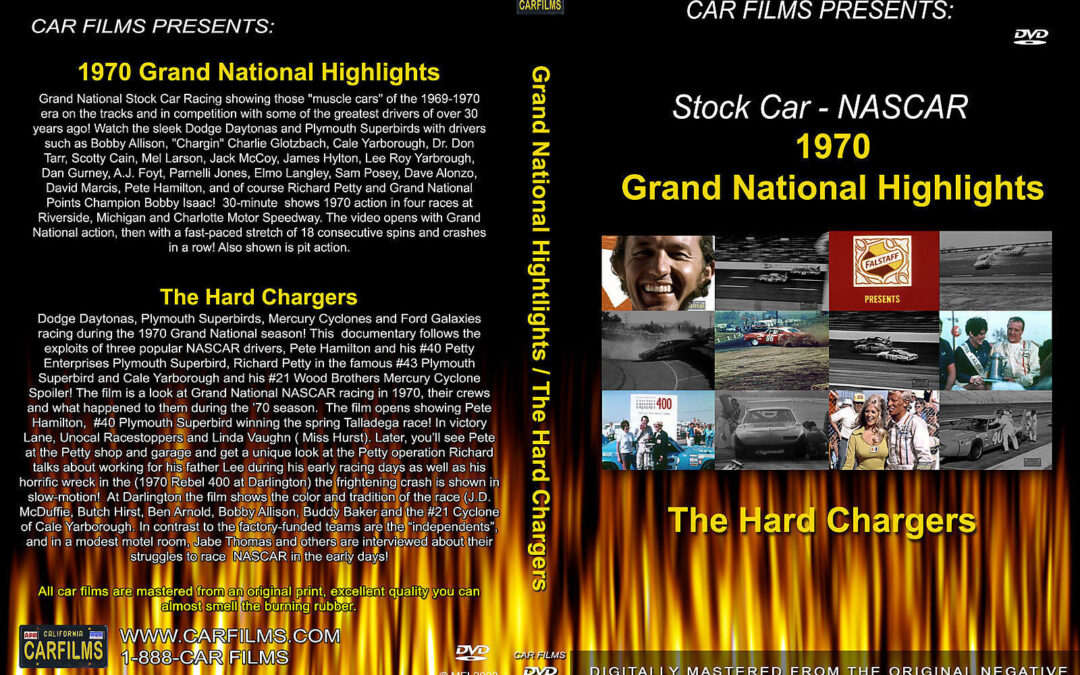
Grand National Stock Car Racing showing those “muscle cars” of the 1969-1970 era on the tracks and in competition with some of the greatest drivers of over 30 years ago! Watch the sleek Dodge Daytonas and Plymouth Superbirds with drivers such as Bobby Allison, “Chargin” Charlie Glotzbach, Cale Yarborough, Dr. Don Tarr, Scotty Cain, Mel Larson, Jack McCoy, James Hylton, Lee Roy Yarbrough, Dan Gurney, A.J. Foyt, Parnelli Jones, Elmo Langley, Sam Posey, Dave Alonzo, David Marcis, Pete Hamilton, and of course Richard Petty and Grand National Points Champion Bobby Isaac! 30-minute shows 1970 action in four races at Riverside, Michigan and Charlotte Motor Speedway. The video opens with Grand National action, then with a fast-paced stretch of 18 consecutive spins and crashes in a row! Also shown is pit action.
The Hard Chargers (60.min)
Hosted by William Conrad
with Linda Vaughn miss Hurst
Dodge Daytonas, Plymouth Superbirds, Mercury Cyclones and Ford Galaxies racing during the 1970 Grand National season! This documentary follows the exploits of three popular NASCAR drivers, Pete Hamilton and his #40 Petty Enterprises Plymouth Superbird, Richard Petty in the famous #43 Plymouth Superbird and Cale Yarborough and his #21 Wood Brothers Mercury Cyclone Spoiler! The film is a look at Grand National NASCAR racing in 1970, their crews and what happened to them during the ’70 season.
The film opens showing Pete Hamilton, #40 Plymouth Superbird winning the spring Talladega race! In victory Lane, Unocal Racestoppers and Linda Vaughn ( Miss Hurst). Later, you’ll see Pete at the Petty shop and garage and get a unique look at the Petty operation Richard talks about working for his father Lee during his early racing days as well as his horrific wreck in the (1970 Rebel 400 at Darlington) the frightening crash is shown in slow-motion!
At Darlington the film shows the color and tradition of the race (J.D. McDuffie, Butch Hirst, Ben Arnold, Bobby Allison, Buddy Baker and the #21 Cyclone of Cale Yarborough. In contrast to the factory-funded teams are the “independents”, and in a modest motel room, Jabe Thomas and others are interviewed about their struggles to race NASCAR in the early days
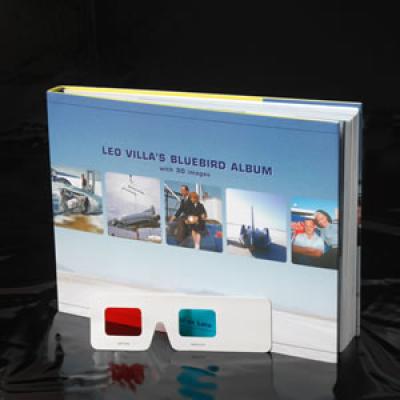
“This is the definitive photographic record of Donald Campbell’s legendary Bluebirds, much of it captured through the twin lenses of Leo Villa’s ‘Stereo Realist’ camera.
An amazing body of photo-journalism in colour (18 in 3D) and black & white, this 256 page hard back book captures the life-and-death drama that was played out against the barren landscapes of salt beds and the magnificent backdrop of lakes such as Coniston Water. With almost 600 photographs contained in its pages, Leo Villa’s Bluebird Album also puts the story in its historic background, showing the fashions and styles of the day. The 3D images are a rare and unusual view of a time when a 3D camera was a hugely expensive novelty. The glasses require to see the images in three dimensions are included in a pocket in the front of the book.
In 1964 Donald Campbell and his team went to Australia with the intention of breaking the land and water speed records in the same year, ‘The Double’. An adventure unsurpassed in record breaking history, fraught with difficulty and obstacles, it was a constant fight against the elements, and the technicalities of high speed vehicles.
For 12 years Donald Campbell dominated the record breaking scene on both sides of the Atlantic, and throughout this period he was aided and advised by Leo Villa, his friend and chef d’équipe, who had known him since childhood.
Leo played a unique part in record breaking history, and helped the team break no less than 10 land speed records, and 11 water speed records with Donald and Malcolm Campbell and their legendary Bluebirds. This fascinating book is a ‘Snapshot’ of time Leo and the Campbells spent travelling the world together.
”
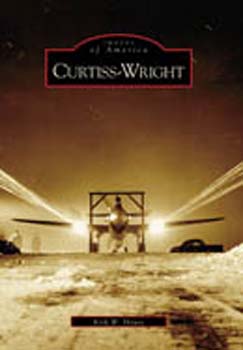
The oldest names in aviation joined forces in 1929, when Wright Aeronautical and Curtiss Aeroplane formed the giant Curtiss-Wright Corporation. Curtiss airplanes were already “the best things with wings,” while Charles Lawrance had made Wright powerplants the leader in American radial engines. Aviation founding father Glenn Curtiss, along with superstars Charles A. Lindbergh, Jimmy Doolittle, Admiral Byrd, and “Wrong-Way” Corrigan, all blazed skytrails with Wright engines and Curtiss wings. Tiny Sparrowhawk biplane fighters flew from airborne dirigibles. Huge factories poured out war birds in tens of thousands for World War II. Pilots flew them everywhere, from the African desert to Alaskan ice, South Sea islands, and even the Taj Mahal. Relive those days when women, old men, and teenagers kept the factories roaring, and follow Curtiss-Wright clear into the 21st century.
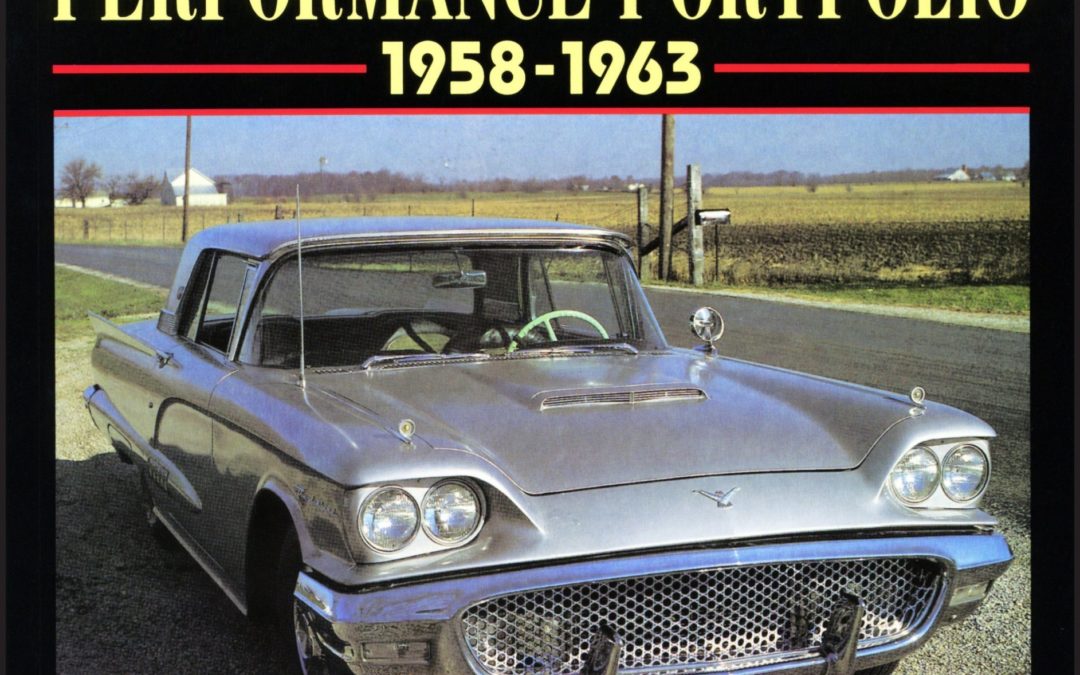
The 1955-57 Thunder-birds introduced luxury features to the two-seater market but buyers made clear that what they really wanted was four seats. The 1958 models were much larger cars with four seats and a unibody shell. They were either convertible or hardtop with a big-block 352ci V8 engine. There were few differences for 1958 and 1959 but the 430ci engine was added to the range. 1961 saw a very different body; a pointed nose and discreet tail fins and a 390ci V8 was added to the options. 1962 brought a Sports Roadster and the Landau model. This is a book of contemporary road and comparison tests, technical and specification data, consumer analysis, new model introductions, history. Models covered include: 352, 430, 390.